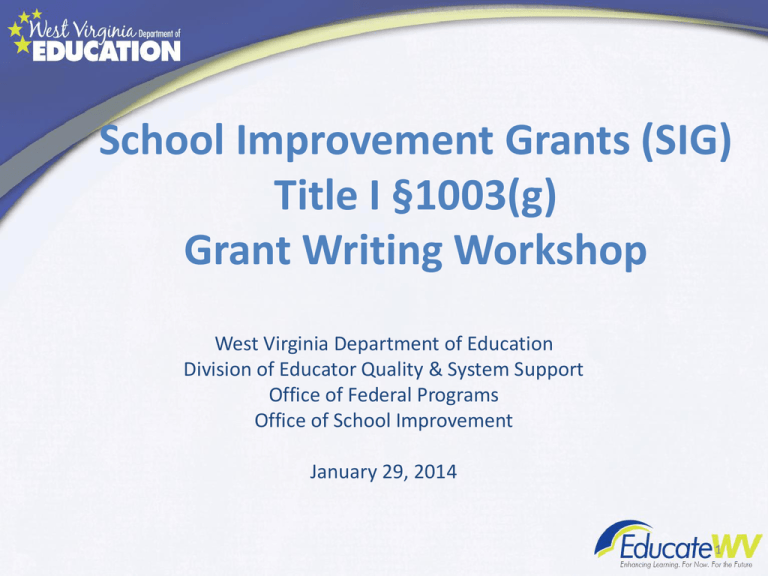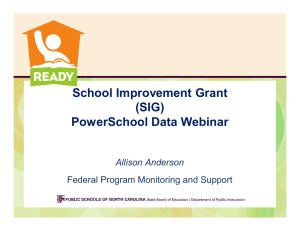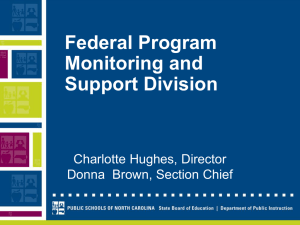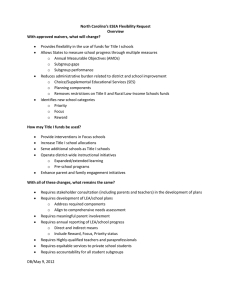School Improvement Grants (SIG) Title I §1003(g) Grant Writing Workshop
advertisement

School Improvement Grants (SIG) Title I §1003(g) Grant Writing Workshop West Virginia Department of Education Division of Educator Quality & System Support Office of Federal Programs Office of School Improvement January 29, 2014 1 Webinar Review • SIG Title I - 1003(g) background documents • Eligible schools • SEA allocation of funds • SIG Intervention Models • SEA and LEA roles • Timeline SIG Title I - 1003(g) Background Documents • USDE Guidance http://www2.ed.gov/programs/sif/index.html – Technical Assistance – Information for Grantees • WVDE Guidance – – – – SEA Application LEA Application List of Eligible School Webinar and Workshop presentations 3 FY13 Eligible SIG Schools DISTRICT SCHOOL DISTRICT SCHOOL Barbour Philippi Middle Logan Buffalo Elementary Barbour Junior Elementary Logan Man Senior High Berkeley Burke Street Elementary Logan Chapmanville Senior High Braxton Braxton County High Mercer Spanishburg School Cabell Peyton Elementary Preston Tunnelton-Denver Elementary Fayette Ansted Elementary Summers Summers County High Fayette Collins Middle Taylor Anna Jarvis Elementary Grant Union Educational Complex Wayne East Lynn Elementary Hampshire Hampshire Senior High Wayne Wayne Middle Kanawha West Side Elementary Webster Webster County High Kanawha J E Robins Elementary Webster Glade Middle Lincoln Lincoln County High Wood Jefferson Elementary Center Lincoln Midway Elementary 4 Allocation of Funds • Federal FY2013 SIG funding will be received by the WVDE by April 2014. • It will be awarded to selected LEAs/Priority schools by the end of May 2014 to begin preimplementation activities. • Funding will be available for: 2014-15 2015-16 2016-17 5 Allocation of Funds (2) • All grants will be targeted for schools; LEA applications will not be funded in this funding cycle • Selection of schools will be done through a competitive application process • Annual budgets can range from $50,000-$2M per school 6 Allocation of Funds (3) • Based on WV’s availability of $3,189,829 for the three year period, funding level expectations are as follows: 3-5 schools will be funded Annual school budgets should range between $200,000 and $400,000 All budgets are subject to negotiation 7 SEA Role • Write and submit the application to ED to receive the 1003(g) funds • Establish criteria related to the overall quality of the LEA’s application and to the LEA’s capacity to implement fully and effectively the required interventions • Select SIG grantees and issue grant awards • Monitor the LEA’s implementation of interventions in and the progress of its participating schools • Hold each SIG funded school accountable annually for meeting, or being on track to meet, the LEA’s student achievement goals LEA Role • Submit a competitive application to the SEA for the 1003(g) school improvement funds • Implement one of the four models in the Priority school(s) it has agreed to serve through its application • Provide adequate resources to each Priority school it commits to serve in order to implement fully one of the four proposed interventions • Establish three-year student achievement goals in reading/language arts and mathematics and hold each funded Priority school accountable annually for meeting, or being on track to meet, those goals Reporting & Evaluation • For schools receiving SIG funds, LEAs/schools will be required to report annual, school-level data on outcome measures and leading indicators • Required Priority school reporting and monitoring will meet most of these requirements • USDE reserves the right to require additional information at anytime throughout the funding period Timeline Dec 2013January 2014 Submit SEA application Provide webinar to LEA leaders with eligible schools Provide an application workshop for LEA/school representatives January 29, 2014 February 2014 Provide technical assistance with the application Receive LEAs applications - due to SEA February 19, 2014 Conduct clarification interviews February 26-27, 2014 May 2014 – September 2017 March – April 2014 Review LEA applications Award LEA grants Implement SIG interventions in selected schools Receive technical assistance from WVDE School Improvement Coordinators Monitor and report progress SIG Intervention Models School closure Turnaround Restart Transformation School Closure and Turnaround West Virginia Applicability • School closure and the turnaround intervention options are complicated by the rural nature of the state – More than half of all West Virginia schools are in rural areas – Approximately 40 percent of students statewide are from rural areas, more than double the national average of 19.4 percent – 25 of the 55 districts in West Virginia support only one high school – It is not realistic to replace the principal and more than fifty percent of the staff in districts that are currently struggling to fill all of their teaching positions with highly qualified teachers Restart This option is not currently an option in WV because there is not a charter school law. If a charter school law would pass in WV, this could be an optional SIG intervention in the future. Transformation The Transformation model is applicable in WV… Under SIG’s transformation model, a school is required to implement all of the following four strategies: Transformation (2) • • • • • Developing Teacher and School Leader Effectiveness Use rigorous, transparent and equitable evaluation systems that take into account data on student growth Identify and reward school leaders, teachers, and other staff who have increased student achievement and the graduation rate Replace the principal who led the school prior to commencement of the transformation model Provide relevant, ongoing, high-quality job-embedded professional development Implement strategies designed to recruit, place, and retain high-quality staff Transformation (3) Implementing Comprehensive Instructional Reform Strategies • Use data to identify and implement comprehensive, researchbased, instructional programs that are vertically aligned from one grade to the next as well as aligned with State academic standards • Promote the continuous use of student data to inform and differentiate instruction to meet students’ needs Transformation (4) Extending Learning Time and Creating Community-Oriented Schools • Provide more time for students to learn core academic content by expanding the school day, the school week, or the school year, and increasing instructional time for core academic subjects during the school day • Provide more time for teachers to collaborate • Provide more time for enrichment activities for students • Provide ongoing mechanisms for family and community engagement Transformation (5) Providing Operating Flexibility and Sustained Support • Give the school sufficient operating flexibility (including in staffing, calendars/time, and budgeting) to implement fully a comprehensive approach to substantially improve student achievement outcomes • Ensure that the school receives ongoing, intensive technical assistance and related support from the LEA, the SEA, or a designated external lead partner organization (such as a school turnaround organization or an EMO). Application Excel Spreadsheet format • Cover page • Part A: Schools to be Served • Part B: Descriptive Information (including District Capacity Index) • Part C: Budget Directions • Individual School Budgets (Total will calculate automatically) • Assurances 20 Application Cover Part A Part B Part B Poor Satisfactory Commendable 1 point 2 points 3 points LEA governance State takeover district Limited SEA intervention No SEA intervention Title I audit reports Findings in areas requiring a repayment of funds Findings in areas noted-repayment of funds not required No findings in the fiscal area Approval of the district strategic plan by OEPA Not approved by OEPA Approved by OEPA with revisions Approved by OEPA without revisions Criteria Points Earned A critical mass of staff has begun to The LEA has not yet begun to address the The practice of PLCs is deeply embedded engage in PLC practice. Members are practice of a PLC or an effort has been in the culture of the LEA. It is a driving Development of schools as professional being asked to modify their thinking as made to address the practice of PLCs, but force in the daily work of the schools. It is learning communities well as their traditional practice. has not yet begun to impact a critical mass deeply internalized and schools would Structural changes are being met to of staff members. resist attempts to abandon the practice. support the transition. Identification of district leadership team and assignment of responsibilities No district leadership team nor identified Lacks specific identification of personnel A specific district leadership team is person assigned for monitoring for the district leadership team and for identified and one or more persons are implementation monitoring implementation. assigned for monitoring implementation. Total Points District Capacity 0 Part B Part B Part B Part C Part C Part C Part D Selection Criteria The following criteria will be utilized to rank applications: • a total score of eleven or more points on the capacity index • Higher point totals received on the Descriptive Narrative for alignment between diagnostic recommendations and goals • Complete and accurate budgets • Completion of all assurance statements Questions WVDE Contacts Office of Federal Programs Melanie Purkey mpurkey@access.k12.wv.us Office of School Improvement Mickey Blackwell mblackwell@access.k12.wv.us Your assigned School Improvement Coordinator





